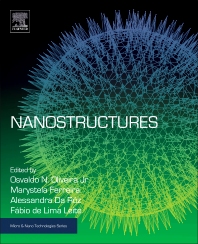Sorry, this entry is only available in Brazilian Portuguese.
Tag: nanotecnologia
From idea to market: nanotechnology for wellness.
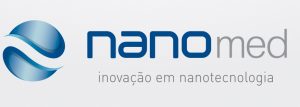 A mix of entrepreneurial spirit, born in childhood, and scientific training, developed in the university stage, led Brazilian Amanda Luizetto dos Santos to create Nanomed two years after completing her doctorate. “The foundation of Nanomed was a natural thing, I always wanted to undertake it, I just needed some time to mature the concept as I imagined,” Amanda states.
A mix of entrepreneurial spirit, born in childhood, and scientific training, developed in the university stage, led Brazilian Amanda Luizetto dos Santos to create Nanomed two years after completing her doctorate. “The foundation of Nanomed was a natural thing, I always wanted to undertake it, I just needed some time to mature the concept as I imagined,” Amanda states.
Early on in her childhood, Amanda used to set up a street stall to sell her drawings. “From an early age entrepreneurship aroused my heart,” she says. Time passed and pastimes became a life goal. At the end of her undergraduate years in Pharmacy, she participated in an initiative to train young entrepreneurs, in which she opened, maintained and closed (with a positive balance, she explains) a decorative candles company. “This experience was very enriching and, in fact, revived my interest in the world of entrepreneurship,” she recalls.
From her undergraduate degree, Amanda went straight to a doctorate in Analytical Chemistry, at the São Carlos Institute of Chemistry (USP), where she dealt with research in essential oils. The doctorate program included a scientific internship in the United States at Cleveland State University. Then, working closely with the cosmetics industry, Amanda noted this market’s demand for innovation and managed to design a first version of the company. “I found what I had been looking for since I was a young girl,” she says.
Located in São Carlos, in the state of São Paulo (Brazil), Nanomed is dedicated to developing and marketing innovative nanosystems, designed to solve specific challenges of the industry segments such as cosmetics, health and wellness. An example of Nanomed’s technology is nanocapsules that protect substances of interest (skin moisturizing molecules, medicine flavorings, insect repellents), transport them in minimal doses and deliver them to the desired location. Nanomed’s nanocapsules and other nanoparticles, Amanda emphasizes, undergo scientific evaluations to check for toxicity to living tissues and the environment.
In addition to developing nanosystems for other companies, the startup is building its product portfolio. The first products, two nanotechnology-based cosmetic lines, will enter the market (via e-commerce) soon. And between the end of this year and the beginning of next, new products of the food and sanitizing segments will be launched.
Nanomed was formally created in 2012 following the approval of a project in the PIPE program of the São Paulo Research Foundation (Fapesp). PIPE supports scientific and technological research in small companies in the state of São Paulo. Shortly after its creation, Nanomed was incubated in the São Carlos Technology Park (ParqTec), where it remained until 2017.
Since its inception, the startup has been dedicated to R&D of its technologies and products and, at the same time, has taken advantage of its ability to perform analysis and testing to provide services, especially to companies in the cosmetics and pharmaceutical segment. Thanks to the provision of services, Nanomed today is self-sustaining, states Amanda, who is the company’s CEO. “However, profit is still being reinvested,” she says.
For its R&D and service activities, Nanomed has equipment at the company’s headquarters, some of them acquired in projects supported by Fapesp and the Brazilian federal agencies Finep and CNPq. In addition, the startup hires specific assays at university labs and other partners.
Fifteen people currently work at Nanomed – partners, employees, fellows and consultants. Most of the team consists of masters and doctors with degrees in Pharmacy, Chemistry, Engineering and Physics, who work in product development and service provision. The startup also has professionals working in the legal and administrative areas.
Below is our interview with Amanda Luizetto dos Santos, founding partner and CEO of Nanomed.
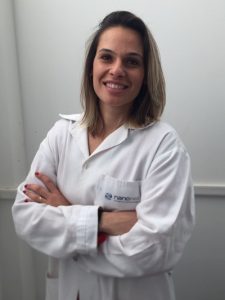
B-MRS Newsletter: What were the most important factors that enabled the creation and development of the startup?
Amanda Luizetto dos Santos: The key factors that enabled Nanomed include the support of Fapesp and ParqTec. Since the beginning of Nanomed, Fapesp has been a fundamental pillar in technology and product developments by financing innovative and high risk projects. ParqTec, which is the oldest incubator in Latin America and is located in São Carlos, was very important because it allowed immersing in the environment of innovative entrepreneurship, as well as supporting the business construction.
B-MRS Newsletter: What were the most important moments for you in the history of the startup?
Amanda Luizetto dos Santos: The most important moment was participating in a meeting at Anvisa’s parliamentary meeting to defend a grade 2 cosmetic product developed by Nanomed and which will be launched and marketed later this year.
[Editor´s Note: Grade 2 products are toiletries or cosmetics whose characteristics require proof of safety and/or efficacy, as well as information on use mode and restrictions].
B-MRS Newsletter: What were the main difficulties the startup has faced thus far?
Amanda Luizetto dos Santos: The main difficulty, still encountered, is the slowness and regulatory bureaucracy that is related to the fact we work in the health area.
B-MRS Newsletter: What do you think is the main contribution of the startup to society?
Amanda Luizetto dos Santos: The main contribution is to offer safe and innovative products to society and contribute to the population’s quality of life.
B-MRS Newsletter: What is your goal/dream for the startup?
Amanda Luizetto dos Santos: Nanomed’s goal is to make people happy and satisfied by offering a line of innovative and high performance products in the domestic and international market.
B-MRS Newsletter: Leave a message to our newsletter readers and social media followers who are considering starting a startup.
Amanda Luizetto dos Santos: I believe we need to be realistic when we think about the future, especially when it comes to opening a business of our own. The idea that to undertake is to have no boss does not exist, in fact, you have thousands of bosses, such as client, employee, government, and many others. So, entrepreneurship means working hard and in all sectors of the business (all of them!). Creating a startup and keeping it alive requires a great deal of work (quite a lot), dedication, resilience and a cool head.
The universe of entrepreneurship is a constant adrenaline rush, particularly addictive, while it brings immense satisfaction to see things come to fruition, that cold feeling in the belly is inevitable. I can’t live without it (I still don’t know if fortunately or unfortunately!).
Royal Society of Chemistry put together a collection of paper of Brazilian authors in honour of XVIII B-MRS Meeting.
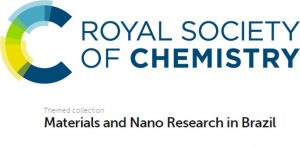 The Royal Society of Chemistry (RSC) has prepared an online collection of articles by Brazilian authors in celebration of the XVIII B-MRS Meeting (Balneário Camboriú, September 22-26, 2019). The Royal Society of Chemistry is a supporter of this edition of B-MRS’s annual event.
The Royal Society of Chemistry (RSC) has prepared an online collection of articles by Brazilian authors in celebration of the XVIII B-MRS Meeting (Balneário Camboriú, September 22-26, 2019). The Royal Society of Chemistry is a supporter of this edition of B-MRS’s annual event.
Titled Materials and Nano Research in Brazil, the collection brings together 55 articles published in RSC journals between 2017 and 2019. All selected articles are open access until October 15, 2019.
The collection is available at www.rsc.li/brazil-mrs-2019
From idea to innovation: nanotechnology for sustainable and productive agriculture.
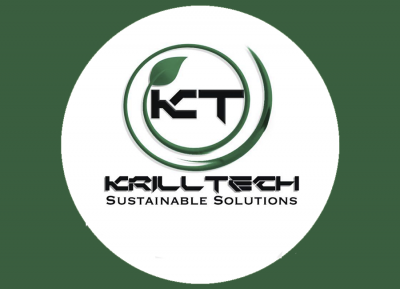 Using nanotechnology to solve important human problems has for many years been a personal goal of Marcelo Oliveira Rodrigues, a professor at the University of Brasília (UnB) and a partner at Krilltech. One of these problems is undoubtedly the problem of food production. Data from the UN and FAO show that food demand will grow by more than 50% by 2050, while the expansion of areas available for agriculture will not keep pace with this growth.
Using nanotechnology to solve important human problems has for many years been a personal goal of Marcelo Oliveira Rodrigues, a professor at the University of Brasília (UnB) and a partner at Krilltech. One of these problems is undoubtedly the problem of food production. Data from the UN and FAO show that food demand will grow by more than 50% by 2050, while the expansion of areas available for agriculture will not keep pace with this growth.
Krilltech was launched on the market this year as the culmination of seven years of research, development and testing. The startup will soon be able to make its contribution, through nanotechnology, to a more productive and ecologically correct agriculture, which produces foods with better nutritional quality. “Our technology is a revolution in the modes of production and the way in which sustainable agriculture is done,” says Rodrigues.
In addition to some projects under development, the startup already has a portfolio of products, which includes a line adaptable to customer needs. The products can be applied to the soil or leaves of plants, or even in water, in the case of hydroponic crops. Krilltech products increase the photosynthesis rates of cultivated plants, make their water consumption more efficient and accelerate their metabolism (biostimulants). At the same time, they act as fertilizers to provide micro and macro nutrients that are necessary for plant growth (nitrogen, carbon, phosphorus, potassium, and others). “Our nanoproducts are multifunctional,” says Rodrigues. The startup also has a product line to incorporate mineral salts such as zinc and iron into grains and vegetables. “Producing potatoes, corn, lentils and chickpeas enriched with iron and zinc will contribute to resolving public health problems associated with the deficiency of essential minerals,” exemplifies the professor – researcher – entrepreneur.
Because they are based on nanotechnology, these biostimulants–fertilizers overcome the limitations of conventional technologies and are able to deliver much more nutrients to the crops. “Stabilizing in aqueous media all macro and micronutrients in a solution requires a high surface area and extremely hydrophilic material. Without nanotechnology this is an extremely difficult task,” explains Rodrigues.
According to him, Krilltech’s products do not affect the biota of soils and bodies of water, they do not accumulate in plant tissues (they are metabolized), and are not toxic to fungi, bacteria and animals. In order to guarantee the non-toxicity of its products, Krilltech counts on results of tests carried out with larvae, worms, fungi, bacteria, fish, several lineages of healthy and tumor cells and mice.
As for Krilltech’s production processes, they are of relatively low costs, partly due to the lean system adopted by the startup, based on leveling production according to demand and focusing on increasing efficiency and avoiding waste in production processes. “We work with sophisticated products, but production processes are efficient and we do not need imported equipment for our production,” says Rodrigues. In addition, Krilltech does not use toxic reagents in its processes and does not generate waste, says Rodrigues.
With these characteristics of its technology, production processes and products, Krilltech wants to gain a place in the growing biostimulant market, currently dominated by multinational companies headquartered mainly in Europe, North America and India. According to estimates reported by Krilltech, the demand for biostimulants will increase mainly in Asia and South America. It is estimated that this market will move around US$ 3.5 billion in 2022.
Emergence of the startup: a partnership between an university and a state-owned research corporation
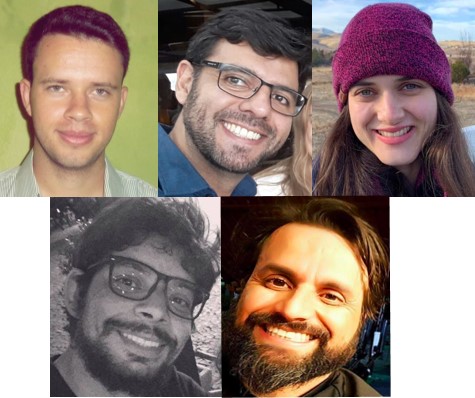
“Transforming scientific research into technologies absorbed by the consumer market has always been a personal desire,” says Professor Rodrigues. So in 2012, shortly after joining UnB as an adjunct professor, he identified projects from his research group that had the potential to become innovations. By 2016, the group had developed a nanoformulation based on a high-cost drug, used in the Brazilian public system to treat fungal infections. “We were able to reduce the toxicity and cost of the drug by about 40 percent, but we were frustrated by the lack of resources to advance pre-clinical studies according to the Brazilian health regulatory agency standards,” says Rodrigues.
Also in 2016, the group began discussions with a unit of the Brazilian Agricultural Research Corporation, Embrapa. Initially, the goal was the development of plastics with special optical properties for use in protected cultivation (greenhouse and similar). “The conversations with Dr. Juscimar Silva (Embrapa) have evolved toward the development of our nanobiostimulants,” says Rodrigues.
The laboratory development of the technology was carried out at UnB, with the participation of undergraduate and graduate students, and with the support of the Brazilian government agencies FAP-DF, CNPq and Capes through scholarships and resources for consumables. “Public funding was essential for the early stages of development,” emphasizes Rodrigues. With support from Embrapa, the technology was tested on tomato, pepper and lettuce. “We are currently evaluating our products in the large monocultures of the country in partnership with national and multinational companies,” says the partner of Krilltech.
In 2018, the startup entered the pre-incubation program of the Technological Development Support Center (CDT) of UnB, which aims to assist in the development of the business model and the formalization of the future company.
Currently, Krilltech, together with UnB and Embrapa, is in the final stage of filing the patent application for the technology used in the products. “Krilltech has the exclusive right to exploit the technologies,” states Rodrigues.
Confident in the high performance of its products and agility in the development of innovations, Krilltech already has new partners and new projects. The startup has a partnership to enable hops culture in the center of Brasil. Also, Krilltech is testing its technology in microgravity conditions to contribute to farming projects outside the planet Earth (space farming). In addition, Rodrigues adds, a second startup will soon be created to explore nanobiopesticides of very low toxicity developed by the group.
See our brief interview with Rodrigues, PhD in Chemistry (2010) from the Brazilian Federal University of Pernambuco.
B-MRS Newsletter: What were the most important factors in enabling the creation and development of the startup?
Marcelo Oliveira Rodrigues: Undoubtedly, the support offered by UnB, the Brazilian Ministry of Science, Technology, Innovation and Communication and EMBRAPA in terms of technology protections, consulting and training were fundamental to the creation of Krilltech. However, I would like to emphasize that the crisis which Brazilian science has been subjected to and the difficulties of entering into cooperation agreements between the University and the private sector were two factors that contributed greatly to initiate this undertaking.
B-MRS Newsletter: What were the main difficulties the startup has faced thus far?
Marcelo Oliveira Rodrigues: Leaving the comfort zone implies difficulties that need to be overcome. Learning to undertake this endeavor required a cultural change in the way we planned and developed our projects; I think that was the great difficulty we have overcome.
B-MRS Newsletter: What, in your opinion, is the startup’s main contribution to society?
Marcelo Oliveira Rodrigues: Our technology contributes to reduce the environmental impact caused by the application of conventional fertilizers. For example, when fertilizer phosphorus and nitrogen are improperly leached to rivers, lakes and oceans, they can induce the formation of dead-zones, as the eutrophication process can induce excessive growth of algae that depletes water oxygen.
Unlike conventional nanomaterials (metal nanoparticles and metal oxides, polymer micelles, etc.), our technology enables the use of nanotechnology in agriculture. Krilltech has contributed to reformulating the fertilizer and phytostimulant industry, since our technology represents:
-The development of sustainable agriculture based on ecological agrochemicals;
-Contribute to eliminate and reduce the use of inputs and practices of hazardous agrochemicals (less hazardous chemical inputs);
-Mitigate environmental and human health risks due to non-toxicity of our products (design of safer chemicals);
-Elimination of the adverse impact of trophic transfer of conventional nanoparticles in the food chain;
-A disruptive paradigm needed for innovation in food production based on green nanomaterials.
B-MRS Newsletter: What is your goal/dream for the startup?
Marcelo Oliveira Rodrigues: We will have Krilltech units scattered around the world, we will see our technology contribute to sustainable development and we will contribute to reduce the impact of nutritional erosion and malnutrition.
B-MRS Newsletter: Leave a message to our newsletter readers and social network followers that assess the possibility of creating a startup.
Marcelo Oliveira Rodrigues: You should master the technology well, know the market and do not give up in the face of difficulties. The innovation environment in Brazil is unhealthy and standing out in these conditions increases the chances of success.
Featured scientist: interview with Prof Daniel Mario Ugarte.
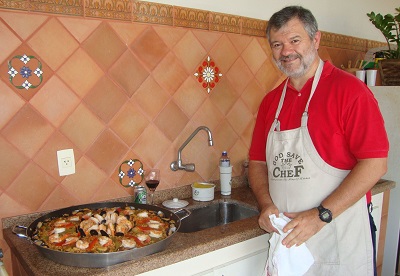
Daniel Mario Ugarte was born on March 23, 1963 in Cosquín, a small town in the mountains of the province of Córdoba (Argentina). He grew up in a family environment that was very stimulating to curiosity, learning and experimentation. After completing his elementary and secondary education in this city, he studied physics in the province’s capital, at the National University of Cordoba, the oldest in the neighboring country (founded in 1613). After graduation, he completed an internship in transmission electron microscopy at Université Paris-Sud, France, where he ended up doing his doctorate in nanoscience subjects (although at that time the “nano” prefix was not yet widely used). Ugarte received his Ph.D. in physics in 1990. He moved to Switzerland where he completed a post-doctorate internship lasting about three years at the École Polytechnique Fédérale de Lausanne (EPFL). There he continued to do nanoscience and nanotechnology and obtained results with great academic impact, notably the “nano-onions of fullerene”, which earned him, at the age of 29, his first article in the journal Nature, signed by him alone and highlighted in the cover of the issue. This paper, which today has more than 2,000 citations, would be the first of six articles published by Ugarte in the two main scientific journals of the world (Science and Nature), among dozens of publications in specialized scientific journals, also of very high impact, such as Nature Nanotechnology, Nano Letters, Physical Review Letters, among others.
In 1993, for personal reasons, Ugarte went to live in Brazil, and began to work with the team that was beginning the construction of the National Synchrotron Light Laboratory (LNLS) at the current site, in the city of Campinas (São Paulo state). It was in this context that he was able to make real his idea of constructing an electron microscope laboratory for research and training really open to the entire scientific community, including students. The Laboratory of Electronic Microscopy began its activities in 1999, directed by the Cordoban scientist, and was the seed of the current National Nanotechnology Laboratory (LNNano). Between 1994 and 1998, Ugarte also served as visiting professor at EPFL. In 2004, he left LNLS to take up the position of associate professor at the Gleb Wataghin Institute of Physics (IFGW), State University of Campinas (UNICAMP). Since 2007, he is a full professor of this institution. In addition, from 2004 to 2007, Professor Ugarte coordinated a research network on nanomaterials, NANOMAT, which included 23 institutions and 150 researchers.
Throughout his scientific career, Daniel Ugarte has delivered more than 100 invited lectures at international scientific events and received several prestigious awards for his exceptional academic contributions, such as the Prix Latsis Universitaire EPFL (Switzerland, 1994), the John Simon Guggenheim Fellowship (USA, 2002), the Scopus Brazil Award from Elsevier and CAPES (Brazil, 2008) and the Physics Award from The World Academy of Sciences, TWAS (Italy, 2018). In 2012, Ugarte was elected a member of the Brazilian Academy of Sciences (ABC). In addition, several students guided by him received prizes for their PhD theses, granted by the Presidency of the Republic, CAPES, the Brazilian Society of Physics (SBF) and the IFGW – UNICAMP.
Daniel Ugarte is the author of more than 100 articles published in international peer-reviewed journals. According to Google Scholar, his academic production received more than 16,600 citations and his h-index is 43.
Take a look at our interview with this founding member of B-MRS and learn more about his life story, his key findings, his criticisms of some trends in how to make science and his message to younger researchers.
B-MRS Newsletter: – We would like to know how / why you became a scientist. When did the desire to be a scientist come to you?
Daniel Ugarte: – I was born in Argentina, with the genetic information typical of that country: mother of Italian origin, and father of Spanish origin (Basque, to be precise), but trying to be English (I love rugby). I think the example of my parents’ curiosity, work, and varied interests had a majority influence on my choices. I was born and raised in a town in the middle of mountains in Argentina (the town of Cosquín, with approximately 10,000 inhabitants, in the province of Córdoba). My mother was a teacher of elementary school and always tried, with very scarce financial resources, to obtain books to continue studying and improve her classes (at that time there was no internet); we read together these new texts of history, dinosaurs, etc. My father, even though he attended school only until he was 12 years old, was always very curious and active. He did everything as an amateur and self-taught; very active, he was an actor, a painter, a musician, he repaired everything, made keys etc. Curiosity and childish spirit were always with him: every new thing, he wanted to dismount to see how it worked. If I had to define his profession, I would say that he made publicity posters. In his workshop, all the equipment was built by himself. In that room of constant mess, I played drilling irons, soldering wires, cutting wood, hammering things. We had few luxuries, no expensive toys, but there were always books, and I did very unusual things (supervised by my parents) in the eyes of other children, such as model airplanes, galena radios, a telescope, etc. With my mother, we always cooked new recipes (gnocchi, cakes, alfajores, sweets, etc.); at 10 years old, every Sunday at noon, I prepared the family barbecue. These experiments of chemistry and heat were very instructive (and tasty), flavors and aromas that I still try to reproduce accurately today. Finally, to complete, I was lucky enough to have some ease with logic and mathematics, which was in evidence when I went to school. I have to thank the Science and Mathematics teachers who worked hard to keep my motivation in that little town so that I could grow and develop this incipient talent. I think that with this childhood, the dream of doing science and working in a laboratory (or a kitchen) making discoveries and building wonderful instruments is the most natural consequence of the world (I must clarify that outside the laboratory my main hobby is to cook).
B-MRS Newsletter: – Briefly tell us what led you to work in the field of nanosystems.
Daniel Ugarte: – In fact I arrived in the “nano” world through electron microscopy. At the Universidad Nacional de Córdoba I studied physics, much more interested in the experimental profile and in the laboratory work using the hands. In the course, you must do a final dissertation to obtain your diploma. Among the various options of the Institute of Physics, I preferred to do a project associated with scanning electron microscopy and X-ray spectroscopy. A pragmatic choice aiming at having more employment options after my graduation. At that moment, I was lucky, an opportunity arose to go to France to do an internship in transmission electron microscopy, and after arriving there (Laboratoire de Physique des Solides, Université Paris-Sud, Orsay), I was invited to do a doctoral thesis to study the excitation of surface plasmas in small particles (in English at the time they were “small particles”, not “nanoparticles” as it is today). The term “nano” did not yet exist, and “plasmon” was only a curiosity (today it is one of the most active nanoscience themes). Once I finished my thesis, I was able to get a postdoctoral fellowship in Switzerland, in one of the first institutes to focus on the new properties of particle size reduction (Institut de Physique Experimentale, Ecole Polytechnique Féderale de Lausanne). In short, I started in the nano embryos and always continued to study small systems with high spatial resolution techniques associated with transmission electron microscopy. The atomic or nanometric resolution of this technique is imperative for basic or technological research in nanosystems, and expensive microscopes have become symbols to display the richness of each “nano” program.
B-MRS Newsletter: – What are your main scientific and technological contributions to the Materials area in your own assessment and why do you consider them to be the most relevant?
Daniel Ugarte: – Carbon nanostructures (fullerenes, nanotubes, graphene) represent a typical example of nanomaterials with novel properties. Considering dates, fullerenes were discovered in 1986, the solid of fullerenes in 1990, the nanotubes in 1991. Working in Switzerland in 1992, I accidentally observed that by irradiating carbon materials with the electron beam of a transmission electron microscope, everything turned into “fullerene onions” (concentric graphite spheres, like a Russian doll). This experiment generated a new member for the newly discovered fullerene family, and the work had an incredible repercussion worldwide. However, the interesting thing was that this was not my postdoctoral project, which was a research focused in the study of electronic diffraction of metallic nanoparticles. In Lausanne we had a complete microscopy lab with all the border equipment. And I noticed that no one wore them at night, so I decide to go and play there … to make exploratory, innocent, alternative experiments and, unintentionally, the onions appeared …. But when I first spoke of the results no one believed; a reviewer for the prestigious journal Physical Review Letters said that my data was as ridiculous as cold fusion (a highly controversial subject at that time); that was an insult of the worst level. But I kept defending my job, I got the same results over and over again, and they were the truth. I continued presenting the result in the conferences; I survived many violent and humiliating comments. To make things a bit out of the paradigm one must have “hard leather”. Finally, with the unexpected and spontaneous support of Sir Harry Kroto (who received the Nobel Prize in Chemistry in 1996), who did not know me and never spoke to me, my article was published in the journal Nature. I was less than 30 years old, very innocent, and I was very surprised by the enormous interest of the media; I reported to many countries, among them Japan, Germany, etc. It felt like the world was falling on my head. With naive (unpretentious) and out of context experiments done at night with advanced instruments, I had created work options that knocked on my door. However, at the moment, to the surprise of my French and Swiss colleagues, I took an alternative route, and in 1993 I choose to live in Brazil for personal and family reasons.
A few years later, in 1995, we were on a Saturday afternoon at the laboratory in Lausanne, making brainstorming proposals with my friend Walt de Heer (an incredible scientist considering depth and creativity). We decided to test one that came up there at the time: using carbon nanotubes (the tip is really thin) to produce a source of electrons. We put together a hydraulic press, plumb-type teflon tape, microscope grids, old mica, some lab things (vacuum chamber, oscilloscope, etc.) and set up something awful, dirty, grotesque, completely improvised, and … it worked !!! . The result was published in the journal Science. This experiment created a new area of applied research for the carbon nanotubes that several industrial laboratories tried to explore; until today it is an active area of research. Again, in my way, another innocent experimental proposal, but creative and relaxed (in this case the result was not accidental, but planned), which captured the interest of the international technological community.
In my group in Brazil, I decided to invest in a new line of research based on an irreverent experiment proposed in Spain by a researcher called Costa-Kramer (Nanowire formation in macroscopic metallic contacts: quantum mechanical conductance tapping a table top, Surf. Sci. 1995). If we add two pieces of gold and then separate them, at the end a very thin yarn (as with chewing gum) is formed which may even have an atom of diameter. By measuring the electric current through this wire during elongation, we can study quantum effects in electrical conduction by nanostructures. In Campinas, my student Varlei Rodrigues (who later received the SBF Prize for Best Doctoral Thesis in Physics in 2003) built an instrument specifically designed to carry out this study with high precision in ultra high vacuum (UHV) conditions. Later we were able to make electron microscopic images of the atomic arrangement of the wires generated by mechanical elongation and also theoretical calculations in collaboration with the group of Douglas Galvão. From this information we could understand in detail our experimental measurements; from these results I was invited to give almost a hundred lectures at international conferences. I believe that these results were very important from the Brazilian point of view, since all the research was done in the country: ideas, advanced experiments, construction of specific scientific instrumentation, theoretical calculations and understanding. In addition to the scientific impact, the research on metallic nanowires represents an important achievement, as it allowed us to show, by example, that competitive experimental nanoscience studies can be done in the country, combining work with originality and a certain degree of risk.
Speaking of results feeds our ego (the little Argentine that we all carry inside …); another aspect of our contribution to society comes when our effort is dedicated to community growth, in particular to raise the level of science in the country. In this sense, I would like to recall one of the most comforting works of my career: the idealization and creation of a multi-user electron microscopy laboratory in Campinas. This project had the constant and unconditional support of the LNLS directors at the time (Cylon da Silva, Aldo Craievich and Ricardo Rodrigues). Finally, the microscopes were acquired with resources (many resources !!!) from The São Paulo Research Foundation (FAPESP). From the initial idea, I worked so that the laboratory was open and available to Brazilian researchers (not in intentions, but in reality) and also had the training of human resources as a focus of their activities. Contrary to the general opinion of the community, in the microscopy laboratory all the observations were made by the undergraduate or graduate students involved in the projects, after a training process. Many students learned to work, and the instruments did not break at all, but we had to give ourselves the time to teach the interested researchers. This mode of operation aimed at avoiding the feudal system (“lord of instruments”) or application of psychophanism. I stayed in this lab until 2009. This laboratory grew and became what is now called the National Nanotechnology Laboratory (LNNano).
B-MRS Newsletter: – You have an unusual amount of articles published in high-impact journals (Science, Nature, PRL …), especially in the context of developing countries. To what factors and competences do you attribute this characteristic of your scientific production?
Daniel Ugarte: – In the previous question I tried to give several examples of some important moments of my scientific activity. Workload, much study, and the courage to take risks were essential to make daring and original experiments. But there is one thing I always try to teach my students: if we do a project, he must bring a relevant contribution (if it works …). If any publication is generated, it has to contribute with new knowledge, not of a lie, but of truth. We will not only choose research topics that generate quick results; probably our study will take time, we will have to understand and deepen in a lot of new thing. We may even need to develop tools / software to answer the scientific question. And my students ask: Will it work? I say, I do not know, if I knew it would work out, it would not have any emotion, but I can guarantee that you will grow a lot and get a solid background. For example, in the topic of gold nanowires we had to respond to comments (from a competitor) on what happened to mechanical elongation at low temperature. For this, we needed to perform an extremely challenging experiment and try to observe the mechanical deformation of nanowire in situ inside the microscope at low temperature with atomic resolution using a sample holder in liquid nitrogen. The student who came across the project (Maureen Lagos, who later won the CAPES thesis award in 2012) asked me: Will it be difficult? What do you think? My answer was: I think it will not work, but to answer this to the community we must test if it works or not, go, try to do your best and good luck (you will need a lot …). To my surprise, he got the measurements, very difficult and time consuming; these studies made here in Brazil receive until today (10 years later) many praises and recognition in the scientific community.
Another aspect, other than risk or daring, is quality; every student or colleague who worked with me knows that we always do the best we can, we don´t have “more or less”. Only the best is accepted, or you have to do the experiment again until you get the highest quality. Some students hate me, but recently an alumnus of UNICAMP (now a professor in the United States) published an article in the journal Nature, and sent me a message thanking me, because today he gives great value to what he has learned with me about drawing his limits. To give total quality to all the study content, in the experiments – which are the basis in our group -, in the theoretical study, in the interpretation, in the modeling, etc. As in all professions, we build our reputation over the years, and it may be prestigious or not. It has always been a pride for my group that our colleagues and competitors receive our works with attention, believing that we have done our best for each published result (but they not always agree with our conclusions / interpretations … as everyone we have many articles rejected).
When I was part of the committee that analyzes projects at CNPq, I was surprised by the number of Brazilian researchers who publish more than, say, 50 articles a year, some of them having high administrative or management positions in Brazilian teaching or research institutions, which requires concentrated effort 24 hours a day. Considering my ability to do research, I find it totally impossible to think about producing almost one publication per week !!! And that if I stayed in the lab all day with the students. At this point I would like to return to the concept of quality, considering the number and the scientific contribution of articles generated by a group or researcher. We can assume that it follows a statistical distribution with Gaussian form described by two parameters with a mean and a width (notes from 1 to 10). I know researchers with a little incoherent production, able to do the best (work note 10), and at the same time, the worst (some papers deserve very low grade, say 1-2). Let´s consider a hypothetical group in which the average contribution to knowledge per publication is good / very good (average 6 or 7), and several dozen publications are generated. Statistically, you must publish a high-quality (top-of-the-distribution and far-out-of-the-middle) article that will get community recognition (hopefully, published in a high-impact magazine). But if you make 100 publications a year and none reaches a certain relevance in your area, our simple statistical model indicates that the average contribution of your work should be moderate. In addition, the width of the distribution can also be moderate; in this situation, the production / work is consistent, in a narrow range of quality level. The causes can be varied; in some cases, it is reasonable to associate a moderate contribution to, for example, the researcher’s youth, poor infrastructure or limited funding. The critical point is when the problem is at the root, and the causes of moderate quality are associated with scientific / technical targets of minor importance and low risk. What to expect from an environment where both funding agencies as well as the researchers themselves (not only the agencies’ fault) accept that this serious disability can be fully compensated for by the number of publications? The result will be that the numbers will increase, but the impact will decrease.
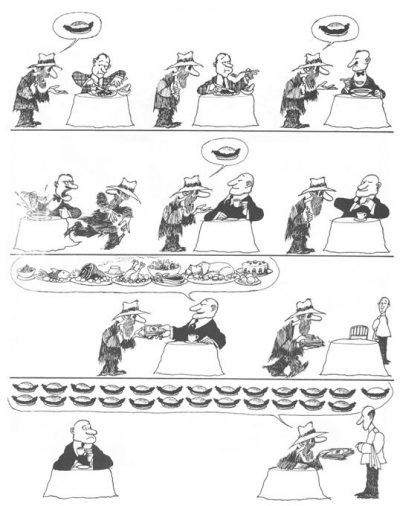
Maybe I’m irresponsible, stubborn (Basque roots help), but my work over the years has followed certain standards. I prefer to make a high-gastronomic dish (sometimes half-burned) than to make hundreds of rice and beans dishes. I prefer to do less things and not have numerous irrelevant publications involving work that did not include any risk (I also have these jobs), and so take the time to update myself, challenge myself, study and see things out of my main interest. So I have the opportunity for new ideas, innocent, irresponsible, that with luck will work. It is important, first, to have clearly in mind what new / different thing we are going to do in our research; if there is nothing new / risky, how will the contribution to the generation of knowledge be? In fact, this line of thinking is not very popular if we look closely at most of the projects funded in the Brazilian community (however, many discourses and plans define it as essential). On the contrary, viability is often more important than relevance and originality. We could also mention other issues that make it difficult to increase the relevance of nanoscience research in Brazil, such as experimental physics, scientific instrumentation, multidisciplinarity, where the contrast between discourse and reality gives great sadness. As in gastronomy, I prefer “slow food”, a good dish, good wine and time to enjoy. We must stand up against “fast science” (short-term projects), as this is leading to shallow-knowledge.
It is sad to see the evolution of Brazil, the numbers grow, the impact decreases … Many can see positively the publication in journals of high impact, but not everyone agrees. Let me give you an example. I decided to study some new subjects where I consider that there are opportunities for very original and interesting things. To ask deeper questions, one must understand. Learning takes time … So, my activity report had problems to be approved for low productivity: I did not reach the average. I have never had much diplomacy or political skills, so joining all my revolt, and being Argentine and Basque at the same time, I wonder: am I terribly inefficient and should I retire, which at least allows me to maintain my spirit, my freedom and form of work intact? There are many discourses on how to stimulate cutting-edge research and train researchers; I think my way of contributing is to work “in my own way” and to give an example to anyone who considers it valid.
I cannot forget to thank CNPq’s Universal system, where I know I can always send crazy ideas, and the review system respects my story and relies on my “irresponsibility”. It’s little money (if compared to international standards), but I get a lot of freedom !!!, and that’s essential to be creative!!!
B-MRS Newsletter: – Now we invite you to leave a message for readers who are starting their scientific careers.
Daniel Ugarte: – Scientific work requires being dreamy and passionate, a lot of effort in study and work. We have to be able to associate knowledge, originality, infrastructure, technical ability, etc. I think it is very important to show young people that it is possible to dream and do cutting-edge research in Brazil. The scientific milieu can be very aggressive, but we must be clear that merit is the most important parameter, and that although the research environment is extremely competitive, it is essential to develop our activities while maintaining the human qualities, professionalism and ethics.
Throughout a scientific career we must face many different situations. My academic life in Brazil had many stages, some were resplendent, with work, challenges, productivity and with excellent and motivated students (the laboratory was paradise). But I also experienced very sad, disappointing stages associated with local mediocracies. However, the stones thrown in our path have been completely overcome by our work, our results and our ethics. Always, always, merit and competence will win in the game of science.
(Português) Inscrições para o mestrado e doutorado em Nanotecnologia da COPPE/UFRJ.
(Português) Processo seletivo para mestrado e doutorado em Engenharia da Nanotecnologia da COPPE/UFRJ.
(Português) Livro sobre materiais funcionais editado por pesquisadores do Brasil é lançado pela editora Springer.
B-MRS at the annual meeting of the Brazilian Society for the Advancement of Science (SBPC).
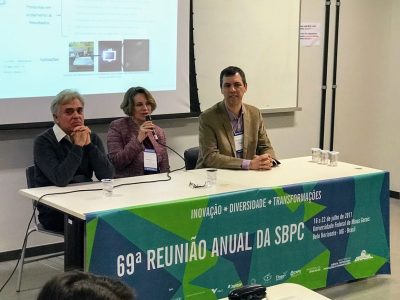
The Brazilian Materials Research Society (B-MRS) was present at the 69th Annual Meeting of the SBPC (Brazilian Society for the Advancement of Science), represented by one of its board members, Professor Glaura Goulart Silva (UFMG). A free event and open to society, the annual SBPC meeting has been held since 1948 in public universities in different Brazilian states. This year, the meeting was held at the Federal University of Minas Gerais (UFMG), in Belo Horizonte (state of Minas Gerais), from July 16 to 22, with the central theme “Innovation –Diversity – Transformations.”
“The 69th Annual SBPC Meeting was an area of resistance to the dismantling of science and technology in Brazil,” declared B-MRS scientific director, Goulart Silva. “The Brazilian community actively involved in science, of all ages, origins and functions, has united in a clear message: science and education are investments, it is on this basis that we can build a future for our people,” she said.
As part of the event’s program, Professor Goulart Silva participated in the roundtable “Carbon Nanostructures: The Next Technological Revolution?” which took place on July 17 from 3:30 p.m. to 6 p.m. The other members of the roundtable were Professor Aldo Zarbin (UFPR), President of the Brazilian Society of Chemistry (SBQ), and Professor Marcos Pimenta (UFMG), coordinator of the INCT of Carbon Nanomaterials and of the Center for Nanomaterials (CTNano), of which Professor Goulart Silva is vice-coordinator.
Carbon nanomaterials, their structure, properties and applications were presented at the roundtable, which had a large audience and many questions raised, focusing on their potential to contribute to various technological areas. “We discussed how nanotechnology can impact a new technological era that has sustainability as a fundamental requirement,” informed the scientific director of SBPMat. “The members and participants of the roundtable expounded on a joint vision that a wide range of nanomaterials will occupy relevant spaces in future technologies. Not only carbon nanomaterials, but also that carbon nanotubes and graphene are indisputably very important systems in this set,” she says.
According to Goulart Silva, all participants in the session emphasized the need for investments in science and technology in Brazil, so that the advances made in areas such as nanotechnology continue.
Reading tips. Book “Nanoscience and Nanotechnology: Principles and Applications” (Elsevier).
“Nanoscience and Nanotechnology: Principles and Applications” is a work distributed in 3 volumes, with a total of 22 chapters written by distinguished experts and scientists from different regions of Brazil. Volume 1 presents topics related to nanostructures; Volume 2, nanocharacterization techniques, and volume 3, examples of applications.
The book was organized by PhDs Alessandra da Róz (IFSP), Fábio de Lima Leite (UFSCar/CCTS), Marystela Ferreira (UFSCar/CCTS) and Osvaldo Novais Oliveira Jr (USP/IFSC). “We noticed that there were few books in Portuguese on Nanoscience and Nanotechnology and we got together to organize the series,” says Marystela Ferreira.
The work was released in 2015 by Elsevier’s Campus publishing house. “The series launched in 2015 was so successful that Elsevier invited us to edit this series in English,” adds Ferreira. The new challenge was accepted and is being carried out by the organizers, with help from the authors and the publisher. The first two volumes in English were released in 2016, and Volume 3 is scheduled to be released in June 2017. In the English language edition, new chapters have been added in order to cover as much material and techniques as possible. “In volume 1 carbon structures was added, and volume 3 presents the SPR technique (surface plasmon resonance),” clarifies Ferreira.
According to Ferreira, the book addresses the basic concepts and fundamental principles of Nanoscience and Nanotechnology, as well as topics such as nanosensors, nanostructured films and nanocharacterization techniques (this was included bearing in mind undergraduate and graduate students conducting experimental research). The series also includes topics on quantum mechanics and computer simulation – topics that have not yet been addressed in Brazilian Nanoscience books – written in simple and direct language, which include applications and illustrations, asserts Ferreira. New lines of research, such as Nanomedicine, Nanoelectronics and Nanoneurobiophysics were also covered in the series. “This work brings together topics in areas such as Biology, Biotechnology, Materials Physics, Medicine, Chemistry and related areas,” emphasizes Ferreira.
The volumes are available on Science Direct (Elsevier’s website for articles and books) and are sold in the form of e-book and printed book on Elsevier’s website.
Links to English edition:



